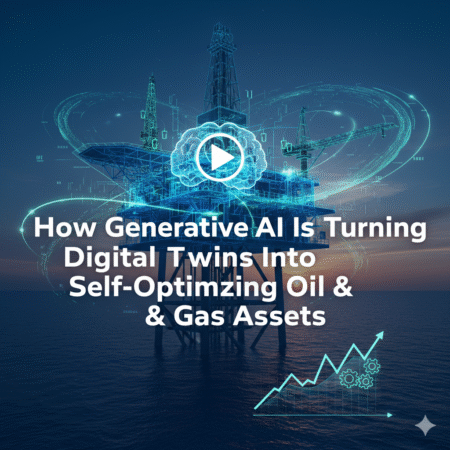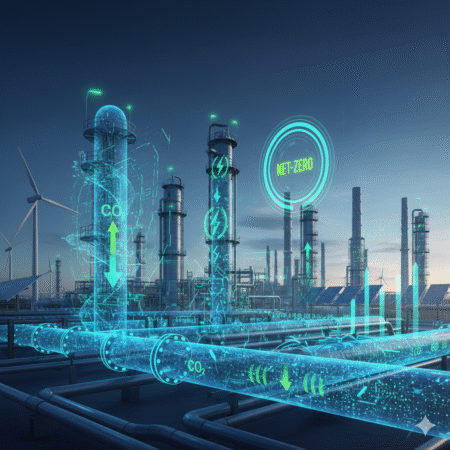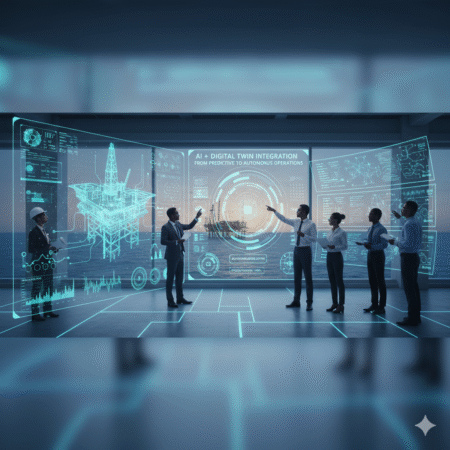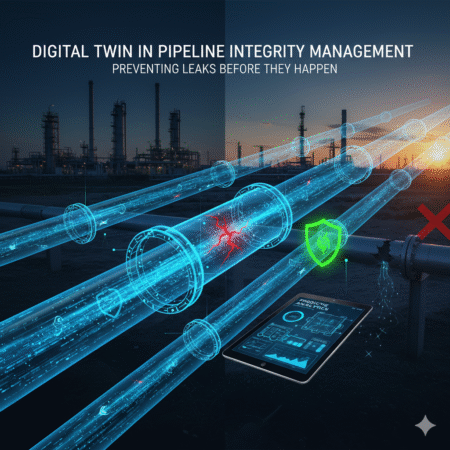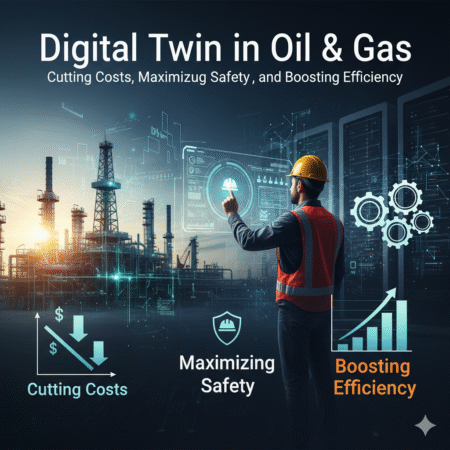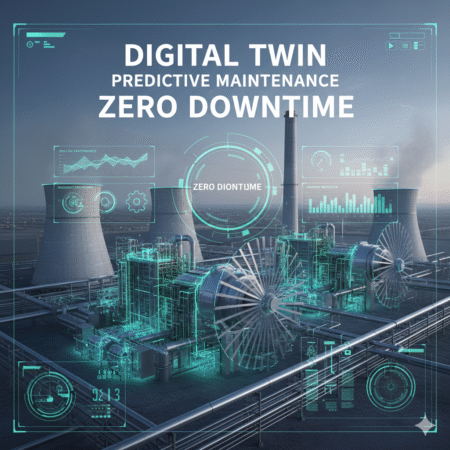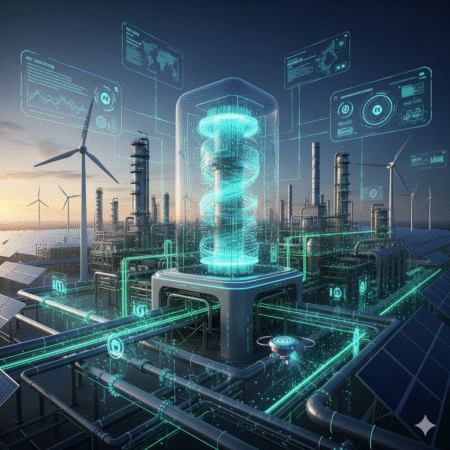
- Introduction: When Machines Start Thinking for Themselves
- What Makes a Digital Twin “Generative”?
- The Technology Stack: From Data to Autonomous Decision
- Core Applications in Oil & Gas
- Generative AI = Predictive, Prescriptive, and Self-Optimizing
- ROI & Business Impact: Beyond Cost Reduction
- Challenges: Why Most Projects Still Fail
- Real Case Studies: Leaders Who Nailed It
- 2025–2030 Roadmap: Toward the Self-Optimizing Oilfield
- Conclusion + FAQ + CTA
Introduction: When Machines Start Thinking for Themselves
In 2024, BP quietly ran a small experiment at one of its offshore platforms in the North Sea. Instead of relying solely on human engineers to monitor compressor performance, they trained a generative AI-powered digital twin to model every possible failure mode – and then teach itself how to prevent it.
Within weeks, the system started suggesting actions that even senior engineers hadn’t considered – like dynamically adjusting compressor speed profiles to prevent surge events during variable flow conditions. The result? A 25% drop in unplanned shutdowns and smoother production flow.
That’s not science fiction – it’s the new face of oil & gas operations.
Every oil company knows that downtime kills profitability. One hour of unplanned shutdown on an offshore rig can cost over $1 million in lost production, according to McKinsey. Multiply that by hundreds of platforms worldwide, and you get why the industry is racing toward autonomous, AI-optimized operations.
But here’s the twist:
The shift isn’t just about automation – it’s about intelligence that learns, predicts, and adapts in real time.
Enter the next evolution:
Generative AI + Digital Twin = Self-Optimizing Assets.
By 2030, analysts project that the AI-driven digital twin market in oil & gas will surpass $15 billion, growing at double-digit rates each year. The reason is clear – operators are done playing defense. They don’t just want to know what happened (descriptive), or what will happen (predictive).
They want to know what’s the best move next, and even better – have the system do it automatically.
Generative AI brings that leap.
It doesn’t just simulate; it creates, tests, and improves.
It can generate thousands of “what-if” scenarios, optimize across conflicting constraints (safety, throughput, emissions), and feed those insights directly into control systems.
In short, digital twins are evolving from digital mirrors to digital brains – systems capable of learning from their own mistakes and self-correcting faster than any human operator could.
The oilfield of the future won’t just be connected – it’ll be cognitively aware.
Assets will learn, collaborate, and optimize in ways that redefine uptime, efficiency, and ESG performance.
This isn’t about replacing people – it’s about empowering them with an ecosystem that thinks ahead.
And in this article, we’ll break down how Generative AI is transforming digital twins into self-optimizing powerhouses – from the tech stack behind it to real-world ROI and a roadmap toward fully autonomous operations by 2030.
What Makes a Digital Twin “Generative”?
Imagine standing in a refinery control room, surrounded by a wall of glowing dashboards – pressure, temperature, flow rates – all mirroring the heartbeat of a billion-dollar operation. That’s your digital twin: a precise, data-driven replica of your physical assets.
Now imagine that same twin doesn’t just mirror reality – it thinks, learns, and acts to optimize operations on its own. That’s the power of a Generative Digital Twin – where simulation meets intelligence.
Traditional digital twins are like mirrors: they reflect what’s happening in real life. They’re powerful, yes – capable of simulating scenarios and predicting outcomes. But they depend heavily on human engineers to interpret the data and decide what actions to take next.
By contrast, a generative digital twin is more like a thinking mirror – one that can understand patterns, generate new possibilities, and self-optimize in real time. Instead of waiting for instructions, it continuously explores millions of operational combinations to discover the most efficient, cost-effective, and sustainable outcomes.
Let’s break this evolution down:
| Type | Function | Limitation |
|---|---|---|
| Conventional Twin | Mirrors physical assets, visualizes performance. | Descriptive only — no intelligence. |
| AI-Driven Twin | Learns from data, predicts failures. | Still needs human decision-making. |
| Generative Twin | Simulates infinite scenarios, proposes and executes optimized actions autonomously. | Emerging — requires high-quality data integration. |
The difference lies in one word: generation.
Generative AI enables the twin not only to simulate but to create – generating new configurations, maintenance schedules, and operational strategies that no human might think of. It combines physics-based modeling with deep reinforcement learning (RL) and large-language-model reasoning (LLMOps), creating a feedback loop that looks like this:
Data → Model → Simulation → Optimization → Action → Learning
This closed-loop cycle turns the twin from a passive observer into an active participant in asset performance management. It doesn’t just tell you what happened – it tells you what should happen next, and then executes that decision safely within defined parameters.
For example, in a recent offshore pilot, a generative twin trained on compressor data learned to adjust load distribution dynamically, reducing energy use by 12% – all without operator intervention. Every cycle it ran made it smarter, learning from every pressure fluctuation, valve delay, and transient event.
That’s the essence of “generative”: continuous, autonomous improvement.
It’s like giving your refinery or drilling platform an AI brain – one that doesn’t sleep, doesn’t panic, and constantly seeks a better way to run.
In short:
A conventional digital twin shows you the present.
An AI-driven twin predicts the future.
But a generative digital twin – it creates the future.
The Technology Stack: From Data to Autonomous Decision
Offshore platform in the North Sea.
The compressor vibration starts to rise – nothing alarming yet, but enough to make a control room operator uneasy. Normally, this would trigger a chain of manual responses: alerts, diagnostics, and maybe a maintenance dispatch. But in a generative AI-powered digital twin, something entirely different happens.
The system doesn’t just flag the anomaly – it simulates thousands of possible causes in milliseconds, evaluates the impact on pressure balance, predicts failure probability, and auto-adjusts compressor load to stabilize the system. No downtime. No panic. Just seamless, intelligent action.
That’s not science fiction. It’s what’s starting to happen right now in AI-integrated digital twin environments – and the secret lies in their technology stack.
Layer 1: The Data Foundation – Sense Everything
Every generative twin begins with data – and lots of it.
Sensors, SCADA systems, IoT devices, CMMS logs, even drone inspections feed the AI’s “nervous system.” But here’s the kicker: raw data alone means nothing. What matters is how it’s cleaned, synchronized, and contextualized.
For example, an oil pipeline twin might pull 100,000 data points per minute – but if pressure data from one sensor lags by 3 seconds, your prediction model could be worthless. That’s why generative twins rely on real-time streaming architectures (like MQTT or OPC-UA) combined with cloud data lakes that fuse structured and unstructured inputs into one consistent flow.
Layer 2: The Twin Model – From Physics to AI
Traditional twins rely solely on physics-based models – built on decades of engineering equations. Generative twins go further by blending them with AI-trained models, creating a hybrid brain that understands both the laws of thermodynamics and the nuances of machine learning.
Example: a refinery twin combines CFD (computational fluid dynamics) with an AI model trained on 5 years of process history. The result? It doesn’t just predict flow irregularities – it learns to anticipate them under unseen conditions, improving accuracy with every data cycle.
This layer transforms “reactive monitoring” into proactive insight.
Layer 3: The Generative AI Engine – Think, Create, and Learn
This is where the magic happens.
The Generative AI engine combines reinforcement learning (RL), large language model operations (LLMOps), and probabilistic simulation. It doesn’t just simulate – it creates new configurations, exploring “what if” scenarios to find the best operational outcomes.
For instance, the twin can test how changing pump sequencing affects fuel efficiency – all in a virtual sandbox – before applying the optimal setting to the live system. Every iteration makes it smarter, forming a self-learning feedback loop:
Sense → Simulate → Suggest → Act → Learn
This loop means your twin never stays static. It continuously evolves – learning from every fault, fix, and fluctuation.
Layer 4: The Action Layer – Closing the Loop
Finally, intelligence becomes action.
Through integration with control systems (like DCS, PLC, or SCADA), the generative twin can safely execute decisions – throttling valves, tuning controllers, or sending prescriptive maintenance orders – all autonomously and securely.
Some companies, like Aramco and Shell, are already piloting these closed-loop AI twins. Early results show uptime improvements of 20–25% and significant energy savings.
In essence, this four-layer architecture transforms data noise into intelligent action.
It’s not just automation – it’s autonomy.
And in oil & gas, where every second of uptime counts, this technology stack could mean the difference between reacting to failure and preventing it altogether.
Core Applications in Oil & Gas
Imagine standing in the control room of a massive offshore platform in the North Sea. The hum of compressors, the steady pulse of pumps, and a digital dashboard showing thousands of live parameters. Suddenly, the pressure readings in one subsea pipeline start to fluctuate.
Normally, this would spark a chain reaction – alerts, manual reviews, and long nights for the maintenance team. But in an operation powered by generative AI-driven digital twins, the system doesn’t just detect the anomaly; it simulates thousands of possible causes, identifies the most likely root issue, and recommends the most efficient corrective action before anything goes wrong.
That’s the power of generative AI inside oil & gas – where data meets intelligence and turns complexity into clarity.
Upstream: Smarter Exploration and Drilling
Drilling has always been a high-stakes game. Every additional hour of non-productive time (NPT) can cost operators millions. Generative AI twins are changing that.
They combine geological data, rig telemetry, and historical drilling records to simulate infinite “what-if” scenarios. Instead of drilling blind, the system suggests the optimal drilling path and real-time parameter adjustments to avoid stuck pipes, kicks, or borehole instability.
For example, BP tested a generative twin prototype that learns from thousands of previous wells to optimize mud weight and bit rotation speed in real-time. The result? A 15% reduction in NPT and fewer unplanned interventions.
But it’s not just about speed – it’s about foresight. The twin doesn’t wait for a problem; it predicts it, tests solutions virtually, and then acts – autonomously.
Midstream: Predicting Leaks Before They Happen
Pipelines are the arteries of the oil & gas world – and one small leak can cost millions in product loss, environmental penalties, and reputational damage. Traditional leak detection systems can take hours to respond. Generative AI twins can predict them hours or even days earlier.
How? By continuously learning from flow dynamics, pressure wave patterns, and temperature anomalies across the network. The twin simulates virtual leaks in different sections to understand their digital signature – allowing the AI to recognize subtle deviations in real-time.
Equinor’s pilot of a generative pipeline twin reduced false leak alarms by 60% and improved response time by nearly 40%. That’s not incremental improvement – that’s transformation.
Downstream: Refining With Intelligence
In refineries, efficiency isn’t just about throughput – it’s about balance: yield, energy, emissions, and maintenance all fighting for optimization. Generative twins tackle this by creating a virtual refinery replica that continuously adjusts operational setpoints to meet dynamic goals – whether it’s maximizing diesel yield or minimizing carbon intensity.
Take Aramco’s generative twin prototype, for instance. It runs reinforcement learning models across multiple process units to simulate outcomes of different parameter combinations – sometimes millions of them — to find the sweet spot between profit and sustainability.
The payoff? A 25% improvement in energy efficiency and a 15% cut in CO₂ emissions, achieved without major equipment upgrades.
Why It Matters
Every part of the oil & gas value chain – upstream, midstream, downstream – faces different challenges, but the goal is the same: make smarter, faster, and safer decisions. Generative digital twins do that by transforming complex operations into self-optimizing systems.
They don’t just mirror reality – they reimagine it.
As one Equinor engineer said, “We no longer just watch the system; the system learns how to take care of itself.”
Generative AI = Predictive, Prescriptive, and Self-Optimizing
In 2018, Shell engineers faced a recurring nightmare: compressor failures that halted production, cost millions in downtime, and took weeks to diagnose. Their digital twin could predict a failure, but it couldn’t tell them why it was happening or how to fix it faster.
Fast forward to 2025 – that same twin doesn’t just predict issues. It prescribes the optimal maintenance plan, runs virtual tests of corrective actions, and even fine-tunes compressor performance on its own through continuous learning.
That evolution – from predictive to prescriptive to self-optimizing – marks the dawn of Generative AI in Digital Twin technology.
Predictive: Seeing What’s Coming
Predictive digital twins are the industry’s first major step toward intelligent operations.
They monitor assets in real time and use machine learning to identify when something might fail.
For example:
A predictive twin can detect abnormal vibration in a centrifugal pump and alert engineers that failure probability is rising by 70% within 48 hours. This insight helps teams plan maintenance instead of reacting to breakdowns.
But prediction alone isn’t enough. In a complex plant with thousands of assets, knowing what’s wrong is only the first step. The real game-changer is knowing what to do next.
Prescriptive: Knowing the Best Next Move
Enter the prescriptive twin. This layer uses Generative AI to go beyond prediction – it simulates potential responses to find the best corrective action.
Imagine a compressor showing early-stage fouling.
The twin runs multiple “what-if” scenarios in real time:
- What if we increase discharge pressure?
- What if we clean now vs. later?
- What’s the cost vs. downtime trade-off?
It then prescribes the most efficient solution – balancing uptime, energy use, and maintenance cost.
This is the difference between reacting to data and thinking with data.
Self-Optimizing: Learning and Acting Autonomously
The highest level of maturity – self-optimizing twins – represents true autonomy.
Here, the system doesn’t just suggest an action. It executes, monitors, and learns from the outcome without human intervention.
For instance, in an offshore platform, a generative twin continuously analyzes compressor energy efficiency. Using reinforcement learning, it adjusts control setpoints to reduce energy use by 10% while maintaining output. If the environment changes – say, inlet gas temperature rises – it automatically reconfigures its control logic.
Over time, the twin becomes smarter, evolving through feedback loops like a living organism.
This is the holy grail of industrial AI – a self-correcting, self-learning, self-optimizing asset.
Evolution Curve: Predictive → Prescriptive → Autonomous
| Maturity Level | Core Capability | AI Role | Business Impact |
|---|---|---|---|
| Predictive | Failure forecasting | Machine Learning | Reactive to proactive maintenance |
| Prescriptive | Optimal decision-making | Generative AI simulations | Efficiency & cost optimization |
| Self-Optimizing | Autonomous execution & learning | Reinforcement Learning | Continuous performance improvement |
The journey from predictive to self-optimizing isn’t just a technological shift – it’s an organizational transformation.
Companies like BP, ADNOC, and Aramco are already proving that integrating Generative AI into their twins leads to double-digit gains in uptime and energy efficiency.
As one BP engineer put it:
“Predictive maintenance saved us money. But when the twin started teaching itself, it made us rethink what ‘optimized’ really means.”
And that’s the new reality – not just smarter machines, but machines that think, act, and evolve.
ROI & Business Impact: Beyond Cost Reduction
When Aramco’s downstream division implemented a generative AI-powered twin across one of its largest refineries, executives expected to save a few million in maintenance costs. What they didn’t expect was a 25% drop in unplanned shutdowns and a 15% reduction in energy waste within the first year – translating to tens of millions of dollars saved.
That’s the power of self-optimizing assets: they don’t just cut costs; they compound intelligence over time.
Read More: AI + Digital Twin Integration in Oil & Gas: From Predictive to Autonomous Operations
From “Efficiency Projects” to “Profit Engines”
For years, oil & gas firms treated digital twins as fancy dashboards – visualization tools to track pumps, compressors, and pipelines. But once Generative AI enters the loop, the twin becomes a decision-maker, not a passive observer.
Here’s the transformation in numbers:
| Metric | Before (Conventional Twin) | After (Generative AI Twin) |
|---|---|---|
| OPEX Impact | 5–10% reduction | 20–30% reduction |
| Asset Uptime | 10–15% improvement | 25–35% improvement |
| Energy Efficiency | <10% | 15–20% improvement |
| Carbon Footprint | Minor reduction | Up to 15% lower emissions |
This isn’t theory – Shell’s Pernis Refinery reported a 20% improvement in heat-exchanger efficiency using AI-driven twin simulations, while ADNOC achieved a 25% increase in gas compression uptime through hybrid predictive-prescriptive twin integration.
The $1 → $8 Return Ratio
According to Deloitte’s 2025 “AI in Operations” report, every $1 invested in digital twin integration (combined with AI) yields $5–8 in returns within 36 months. These returns come from four pillars:
1️⃣ Reduced Downtime: predictive anomaly detection prevents catastrophic shutdowns (each hour offshore can cost >$1M).
2️⃣ Optimized Energy Consumption: generative AI dynamically adjusts operations for lowest energy intensity.
3️⃣ Asset Life Extension: AI-driven maintenance strategies extend component life by 10–15%.
4️⃣ Decision Velocity: teams make faster, data-driven calls – moving from quarterly reviews to real-time optimization cycles.
When these compounding gains stack across hundreds of assets, the financial delta becomes exponential.
Hidden ROI: Knowledge, Safety, and Sustainability
The often-ignored benefits lie outside the balance sheet:
- Safety: generative twins predict unsafe operating envelopes before human error occurs.
- Knowledge Retention: tribal knowledge is digitized and embedded in the AI model.
- Sustainability: continuous optimization means reduced emissions, waste, and flaring events.
These factors also strengthen ESG performance – a growing differentiator in boardroom and investor discussions.
From ROI to Competitive Moat
In the 2020s, automation provided cost advantage. In the late 2020s, self-optimization becomes the moat. Early adopters like BP and Petronas aren’t just saving money – they’re building autonomous intelligence compounds that competitors can’t easily replicate.
The next wave of leaders won’t ask, “How much can we save?” but rather, “How much faster can our assets learn?”
And in that race, Generative AI Twins are setting the new benchmark for operational ROI – one that keeps growing even when you sleep.
Challenges: Why Most Projects Still Fail
When a major European operator launched its “Generative Twin Pilot” for a subsea compression system, the idea sounded bulletproof – real-time optimization, AI-driven fault prevention, and millions in savings. Six months later, the project was quietly shelved. Why? Not because the technology failed, but because the organization wasn’t ready for it.
This is the reality many oil & gas companies face in 2025: they want the results of Generative AI, but their foundations are still stuck in 1999.
Barrier #1: Data Silos & Legacy Systems
Most industrial sites still run fragmented data architectures – SCADA in isolation, CMMS not integrated, IoT data stuck in proprietary systems. Generative AI thrives on holistic, high-quality data, not bits and pieces scattered across servers.
Solution: Establish a Unified Data Layer – integrating OT (Operational Technology) and IT streams through a secure data lake or data mesh. Companies like Equinor use a “digital backbone” to unify drilling, maintenance, and production data – the cornerstone of any successful AI-twin project.
Barrier #2: Lack of AI-Ready Data
You can’t train intelligence on bad data. Generative models depend on clean, contextualized, and labeled datasets. In most oil & gas firms, sensor drift, inconsistent tagging, and missing metadata cripple model training.
Solution: Implement Data Quality Governance – standardize data labeling (ISO 15926 for engineering), automate anomaly detection in input signals, and continuously retrain AI pipelines with validated historical data.
Barrier #3: Cybersecurity & Trust
Connecting AI twins to live control systems introduces new risks. A generative twin that can “suggest” or even “act” must be trusted – otherwise operators will override it out of fear.
Solution: Use AI Control Sandboxing – let the twin operate in a closed simulation loop first, comparing its recommendations to human operator decisions. Over time, confidence builds as its accuracy and consistency prove superior.
Barrier #4: Skill & Culture Gap
Technology isn’t the main bottleneck – mindset is. Many engineers and operators still view AI as a threat rather than a tool. Meanwhile, data scientists often lack domain context to interpret refinery or subsea data.
Solution: Build Hybrid Teams – pair control engineers with AI specialists and encourage cross-domain upskilling. BP’s “AI Ambassador Program” showed a 40% improvement in adoption when teams understood the why behind the tech.
Barrier #5: Integration Chaos
Many pilots fail not because of bad AI – but because of integration misalignment. Different vendors, formats, and protocols create digital friction. Generative AI can’t self-optimize in a fragmented environment.
Solution: Adopt Open Standards and Interoperable Architecture (OPC-UA, MQTT, ISO 14224). These allow the twin to “speak” across systems – from sensors to enterprise dashboards – without custom patches.
Mini Infographic Concept:
Top 5 Barriers vs How to Overcome Them
| Barrier | Impact | Solution |
|---|---|---|
| Data Silos | No holistic insight | Unified Data Layer |
| Bad Data | Poor AI accuracy | Data Governance |
| Cybersecurity Fear | Low trust in AI | Sandboxed Control |
| Skill Gap | Resistance to adoption | Hybrid Teams |
| Integration Chaos | Project failure | Open Standards |
The Real Lesson
Generative AI twins don’t fail because the math is wrong – they fail because the ecosystem isn’t mature enough to support intelligence. The smartest AI can’t compensate for bad data, weak culture, or poor integration.
If you want a self-optimizing oilfield, start not with algorithms – but with alignment.
Because when your data, people, and systems speak the same language, your AI finally starts to think.
Real Case Studies: Leaders Who Nailed It
When Aramco’s Ras Tanura refinery deployed its first AI-powered digital twin, even the engineers were skeptical. “How can an algorithm understand our refinery better than we do?” one veteran asked. Fast-forward 18 months – unplanned shutdowns dropped by 40%, maintenance scheduling became predictive instead of reactive, and the refinery reported multi-million dollar savings in OPEX. The answer wasn’t magic – it was Generative AI meeting decades of process data.
This is how the new wave of oil & gas leaders are rewriting the rules of industrial efficiency – turning what used to be static digital twins into self-learning systems that continuously simulate, optimize, and act. Let’s break down how the front-runners – Aramco, BP, and Petronas – made it happen.
Aramco: From Reactive to Self-Learning Refinery
Aramco began by integrating physics-based simulation models of its crude distillation and flare systems with a Generative AI engine trained on 20 years of operational data. The twin didn’t just monitor – it started suggesting corrective actions when process deviations appeared.
Result:
- Unplanned shutdowns ↓ 40%
- Maintenance response time ↓ 30%
- Throughput ↑ 5% without additional energy use
But the real breakthrough came when the twin learned to self-calibrate, refining its model based on operator feedback and real-time sensor validation. This closed the loop between human expertise and autonomous intelligence – a core principle of self-optimizing twins.
BP: Generative AI for Flare Optimization
BP’s North Sea platform struggled with excessive flaring due to complex transient loads. Engineers built a Generative Twin that ran continuous reinforcement learning simulations – thousands of “what-if” flare scenarios per hour.
Impact:
- Flaring events ↓ 28% in the first year
- Emissions ↓ 17%
- Platform energy efficiency ↑ 11%
The AI learned to predict flare spikes before they occurred and recommended preemptive valve adjustments. What once took human operators 30 minutes of troubleshooting was now an automated 3-second decision.
BP’s digital transformation lead summarized it best:
“Our twin doesn’t just predict. It plays chess with the process – thinking six moves ahead.”
Petronas: Offshore Maintenance Reinvented
Petronas took a hybrid approach in its offshore operations – blending 3D visualization twins with Generative AI anomaly detection. The twin continuously analyzed vibration, temperature, and corrosion data from 12,000+ sensors.
When the AI detected micro-patterns suggesting early pump degradation, it triggered proactive interventions weeks before failure.
Results:
- Maintenance cycles became 20% faster
- Crew exposure to hazardous conditions ↓ 35%
- Maintenance cost savings of ~$12M annually
The Compounding Advantage of Early Adopters
The biggest win for these companies isn’t just ROI – it’s data compounding. Every operational hour feeds the twin with new insights, making it smarter and faster. Unlike conventional twins that plateau in performance, generative models improve exponentially.
Each simulation teaches the twin new relationships between variables – temperature, flow, pressure, yield – forming a living, evolving operational brain.
As one ADNOC executive noted during a 2024 digitalization panel:
“In five years, your biggest asset won’t be your oilfield – it’ll be your trained digital twin.”
These pioneers prove one thing: Generative AI isn’t a futuristic idea – it’s already redefining operational excellence. Those who wait risk being left behind in an industry where the smartest system – not the biggest rig – wins.
2025–2030 Roadmap: Toward the Self-Optimizing Oilfield
When BP engineers first introduced a semi-autonomous control system to optimize flaring in 2023, the biggest challenge wasn’t the algorithm – it was trust. Operators were uneasy about letting AI “decide” on valve adjustments in a live system handling millions of dollars of hydrocarbons per hour. But after six months of consistent, verified results – fewer spikes, lower emissions, and smoother operations – the team realized something profound: the refinery was teaching itself to be better.
That moment captured the future of the oil and gas industry – a shift from predictive to generative to fully autonomous operations. The coming five years will determine which companies evolve into self-optimizing enterprises and which remain trapped in yesterday’s manual paradigms.
Stage 1: Predictive Integration (2025–2026)
Most players today are still here. They use AI for anomaly detection, predictive maintenance, and process monitoring – but the human is still the decision-maker. In this stage, the focus is on:
- Integrating disparate data silos (SCADA, DCS, ERP, CMMS).
- Building unified digital twin frameworks that can feed AI models.
- Training operators to interpret predictive insights instead of static dashboards.
McKinsey reports that only 28% of oil & gas companies have achieved full predictive reliability across their assets. Yet those who did – like ADNOC and Equinor – report up to 30% higher equipment uptime and faster decision loops.
Stage 2: Generative Hybrid Twin (2027–2028)
Here’s where the real transformation happens. Generative twins begin simulating multiple operational scenarios per second – from adjusting separator pressures to forecasting crude quality impact. They not only predict outcomes but generate and test solutions autonomously before suggesting the best one to humans.
Think of this as “AI copiloting your refinery.”
Engineers shift from operators to supervisors of intelligence.
Aramco’s ongoing pilot programs in Dhahran show early evidence: generative AI twins running reinforcement learning models are reducing optimization cycle times by 60%, and discovering process correlations that human engineers missed entirely.
Stage 3: Full Autonomous Twin Ecosystem (2029–2030)
By the end of the decade, digital twins will evolve into closed-loop autonomous systems – continuously sensing, simulating, optimizing, and acting without human initiation. Every process unit becomes a self-learning organism connected through an enterprise AI layer.
Imagine a smart oilfield where:
- AI coordinates drilling schedules with market forecasts.
- Autonomous twins adjust pipeline flows for minimal energy loss.
- Refinery networks auto-balance production loads across sites.
This isn’t science fiction – it’s the trajectory major operators are already mapping. Gartner projects that by 2030, over 45% of oil & gas assets will operate under AI-assisted control, slashing OPEX by up to 35% and emissions by 20%.
The ESG & Human Edge
Beyond cost and efficiency, self-optimizing oilfields will redefine the industry’s sustainability narrative. Smarter twins mean fewer leaks, lower flaring, and optimized energy intensity. But just as crucial – they preserve institutional knowledge, translating decades of engineering experience into models that keep learning even when humans retire.
As Shell’s VP of Digital Transformation said:
“We’re not replacing engineers – we’re immortalizing their intelligence inside our assets.”
Bottom line:
Between 2025 and 2030, the winners in oil & gas won’t be those with the biggest fields, but those with the smartest twins – systems that think, adapt, and evolve faster than the competition.
The path is clear: from simulation → prediction → generation → autonomy.
Conclusion + FAQ + CTA
“The next competitive edge won’t come from data – but from how fast your assets can learn.”
When you zoom out and look at the last 20 years of oil & gas transformation – from manual meters to digital twins, from spreadsheets to AI copilots – one thing becomes clear: this industry has always been about who adapts first.
In 2010, Shell pioneered predictive maintenance using sensor analytics. By 2020, ADNOC was integrating digital twins across offshore assets to cut downtime. And now, as we enter 2025, the race is no longer about predicting failures – it’s about creating systems that can predict, prescribe, and optimize themselves in real time.
Generative AI is not just an upgrade to the digital twin; it’s an evolution.
It’s turning passive digital models into active, intelligent ecosystems – ones that can simulate thousands of “what-if” scenarios, generate optimal responses, and even execute them autonomously.
The Big Picture: What This Means for Oil & Gas
A decade ago, the idea of a “self-optimizing oilfield” sounded futuristic. Today, it’s already on pilot mode.
Here’s what it changes:
- Reliability – assets learn and adapt without human micromanagement.
- Safety – real-time risk simulations prevent incidents before they happen.
- Sustainability – optimized energy use and reduced emissions align directly with ESG mandates.
- Workforce – engineers evolve from operators to AI supervisors, focusing on strategic insights rather than firefighting.
In short: the oilfield of 2030 won’t just run on oil – it’ll run on intelligence.
Quick FAQ: Real Questions from the Field
Q1: How much does it cost to implement a generative digital twin?
It depends on scale, but most pilots range between $2–10 million, with full-scale rollouts paying back within 3–5 years via OPEX reduction and efficiency gains.
Q2: What about cybersecurity risks?
That’s one of the top challenges. Companies are adopting zero-trust architectures and AI-driven anomaly detection to secure autonomous systems.
Q3: Can small operators afford it?
Yes – cloud-based AI twin platforms are lowering the entry barrier. Many vendors now offer modular twin solutions that scale gradually with asset size.
Q4: What’s the realistic ROI timeline?
Most early adopters report measurable ROI within 18–24 months, especially in maintenance, energy optimization, and downtime prevention.
Q5: Will humans still be needed?
Absolutely. Generative AI amplifies human intelligence – it doesn’t replace it. The human role simply shifts from doing to designing, validating, and strategizing.
Final Takeaway
If your plant is still collecting data but not learning from it – you’re already falling behind.
Generative AI turns digital twins from static reflections into dynamic, evolving brains for your operation. The companies that embrace this shift today will dominate cost, safety, and sustainability metrics tomorrow.
So here’s the question:
Are your assets just being monitored – or are they learning to optimize themselves?
👉 Stay ahead of the curve. Subscribe to EngineerDaily.News for deep-dive insights into Industrial AI, Digital Twin evolution, and the future of autonomous oil & gas operations.
Get weekly analyses, case studies, and visual explainers – straight from the engineers shaping tomorrow’s energy landscape.
